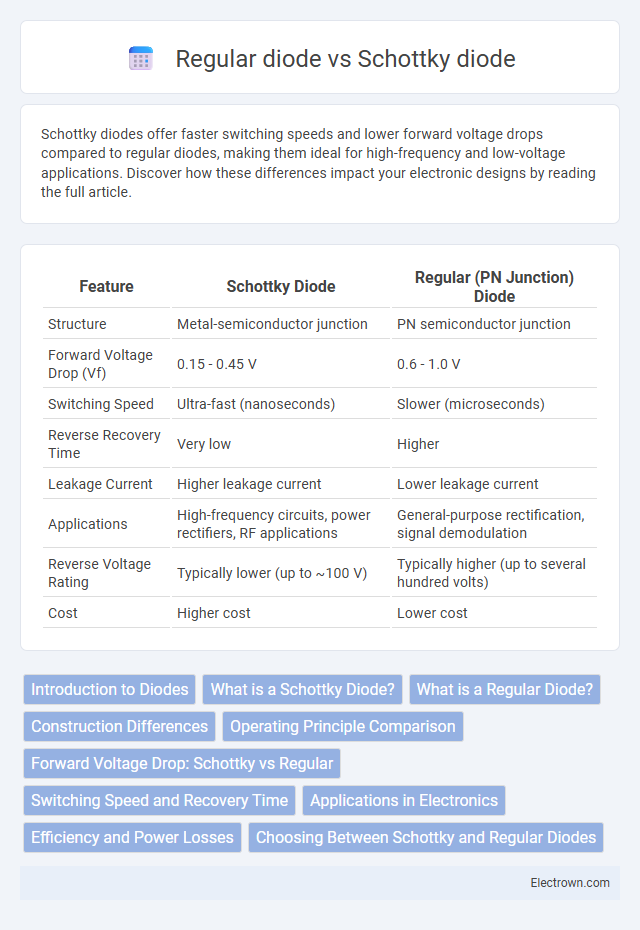Schottky diodes offer faster switching speeds and lower forward voltage drops compared to regular diodes, making them ideal for high-frequency and low-voltage applications. Discover how these differences impact your electronic designs by reading the full article.
Table of Comparison
| Feature | Schottky Diode | Regular (PN Junction) Diode |
|---|---|---|
| Structure | Metal-semiconductor junction | PN semiconductor junction |
| Forward Voltage Drop (Vf) | 0.15 - 0.45 V | 0.6 - 1.0 V |
| Switching Speed | Ultra-fast (nanoseconds) | Slower (microseconds) |
| Reverse Recovery Time | Very low | Higher |
| Leakage Current | Higher leakage current | Lower leakage current |
| Applications | High-frequency circuits, power rectifiers, RF applications | General-purpose rectification, signal demodulation |
| Reverse Voltage Rating | Typically lower (up to ~100 V) | Typically higher (up to several hundred volts) |
| Cost | Higher cost | Lower cost |
Introduction to Diodes
Schottky diodes, known for their low forward voltage drop and fast switching speed, differ significantly from regular silicon diodes in structure and performance. While regular diodes rely on a p-n junction, Schottky diodes utilize a metal-semiconductor junction, resulting in reduced power loss and improved efficiency. Your choice between these diodes affects circuit responsiveness and energy consumption, especially in high-frequency or low-voltage applications.
What is a Schottky Diode?
A Schottky diode is a semiconductor device formed by the junction of a metal and a semiconductor, known for its low forward voltage drop and fast switching speed compared to regular PN-junction diodes. Its metal-semiconductor interface creates a Schottky barrier, enabling minimal charge storage and reduced recovery time, making it ideal for high-frequency and power efficiency applications. Commonly used in power rectification, RF circuits, and voltage clamping, Schottky diodes improve performance where fast switching and low power loss are critical.
What is a Regular Diode?
A regular diode, also known as a PN junction diode, is a semiconductor device that allows current to flow in one direction while blocking it in the opposite direction. It consists of a p-type and an n-type semiconductor material joined together, creating a depletion region that controls the flow of electrons and holes. You rely on regular diodes for rectification in power supplies, signal demodulation, and voltage regulation in various electronic circuits.
Construction Differences
Schottky diodes feature a metal-semiconductor junction, contrasting with regular diodes that use a p-n semiconductor junction. This unique construction results in lower forward voltage drop and faster switching speed for Schottky diodes. Your choice between the two depends on the specific efficiency and speed requirements of your circuit design.
Operating Principle Comparison
Schottky diodes operate using a metal-semiconductor junction, enabling faster switching speeds and lower forward voltage drop compared to regular PN-junction diodes, which rely on a semiconductor-semiconductor junction. The metal-semiconductor interface in Schottky diodes minimizes charge storage, resulting in reduced reverse recovery time and enhanced efficiency in high-frequency applications. Regular diodes exhibit higher forward voltage and slower response due to charge carrier recombination in the depletion region, impacting performance in fast-switching circuits.
Forward Voltage Drop: Schottky vs Regular
Schottky diodes feature a significantly lower forward voltage drop, typically ranging from 0.15 to 0.45 volts, compared to regular silicon diodes which usually drop around 0.7 volts. This reduced voltage drop in Schottky diodes results in lower power loss and higher efficiency, especially critical in power-sensitive applications like power supplies and RF circuits. Your circuit's performance can improve noticeably by choosing a Schottky diode when minimizing energy dissipation and heat generation is essential.
Switching Speed and Recovery Time
Schottky diodes exhibit significantly faster switching speeds and shorter recovery times compared to regular PN junction diodes due to their metal-semiconductor junction, which minimizes charge storage. These characteristics make Schottky diodes ideal for high-frequency applications and power rectification where efficiency and rapid response are critical. In contrast, regular diodes have slower recovery times because their depletion region requires more time to return to equilibrium after conduction.
Applications in Electronics
Schottky diodes are preferred in high-speed switching applications and power rectification due to their low forward voltage drop and fast recovery time, making them ideal for use in power supplies, RF circuits, and solar cells. Regular diodes, with their higher voltage drop and slower switching speeds, are commonly used in general-purpose rectification and voltage regulation tasks where efficiency and speed are less critical. Your choice between Schottky and regular diodes depends on the specific electronic circuit requirements, especially concerning efficiency, switching speed, and thermal performance.
Efficiency and Power Losses
Schottky diodes exhibit higher efficiency and lower power losses compared to regular PN-junction diodes due to their metal-semiconductor junction, which results in a lower forward voltage drop typically around 0.2 to 0.3 volts versus 0.7 volts for silicon diodes. This reduced forward voltage drop minimizes heat generation and improves overall circuit performance, especially in high-frequency and low-voltage applications. Consequently, Schottky diodes are preferred in power-sensitive designs where energy efficiency and thermal management are critical factors.
Choosing Between Schottky and Regular Diodes
Choosing between Schottky and regular diodes depends on the application requirements such as switching speed, forward voltage drop, and leakage current. Schottky diodes offer faster switching speeds and lower forward voltage drops (typically 0.2 to 0.3 volts) compared to regular silicon diodes (around 0.7 volts), making them ideal for high-frequency and low-voltage circuits. Regular diodes provide higher reverse voltage tolerance and lower leakage currents, which suits power rectification and voltage protection applications.
Schottky diode vs regular diode Infographic

 electrown.com
electrown.com